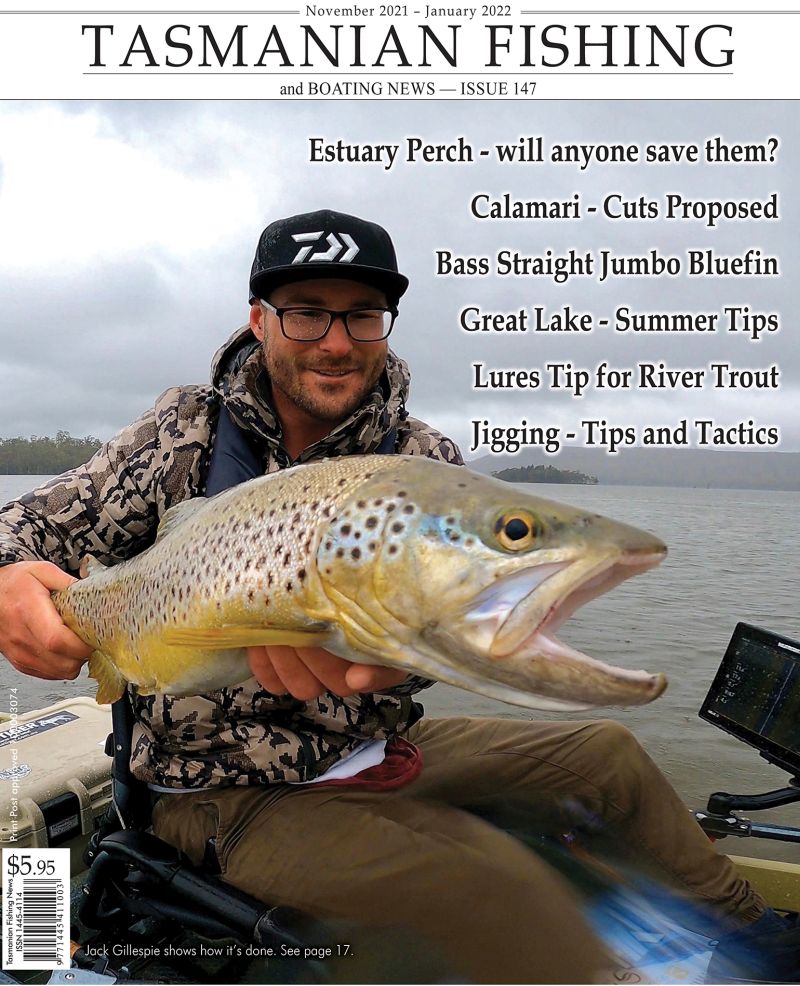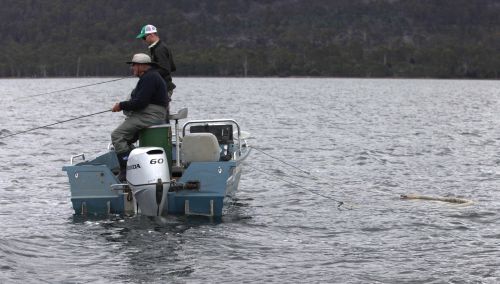From the Archives ...
"Angling is an art - Hannah Ledger
and an art worth your learning.."
Presented from Issue 112, October 2014
So said Izaak Walton in the 1600s. It seems that Burnie’s Hannah Ledger has combined angling with art rather well. Hannah is a fish fanatic, outdoor enthusiast and budding, self-taught artist. From as young as she can remember, she has always had crayon in hand, colouring book under arm and as she’s grown as a painter, jars full of paintbrushes and cupboards full of ready-to-go blank canvas’.
A country girl at heart, Hannah was schooled at Yolla District High School, a small ‘farm’ school in the states North West, then went on to Hellyer College where she was given the opportunity to really grow her art skills; And by grow, that meant skipping the classes that would probably have more an impact of getting her somewhere in life, like English and Math to spend every spare minute with the art teacher, painting or drawing.
As typical teenagers do, they make poor decisions- and after being accepted in to one of the countries top art schools, turned down the offer and decided to move to the big island, where she lived for 5 years working in what seemed ‘dead end’ retail.
Read more ...Please check all relevant authorities before fishing - www.ifs.tas.gov.au and dpipwe.tas.gov.au . Don't forget issuu.com/stevenspublishing for years of back issues !
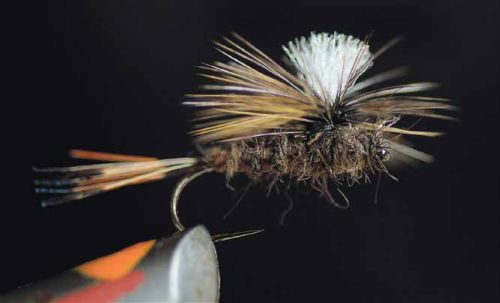 Presented from Issue 101
Presented from Issue 101
That time of year has finally arrived. The rivers start to settle after a winter full of cold weather and rains. The water of the highland lakes warms. Combine this with warmer weather patterns and you little beauty it all begins to happen. What am I talking about, well I reckon you have guessed it by now, the mayflies will be starting to hatch.
The famous hatches from the slow, flat lowland rivers of Tasmania’s Northern Midlands area should be well under way and the mayfly waters of the central plateau should follow, if they haven’t already started.
- Written by Stephen Smith - Rubicon Web and Technology Training
- Category: Fly Fishing
- Hits: 8524
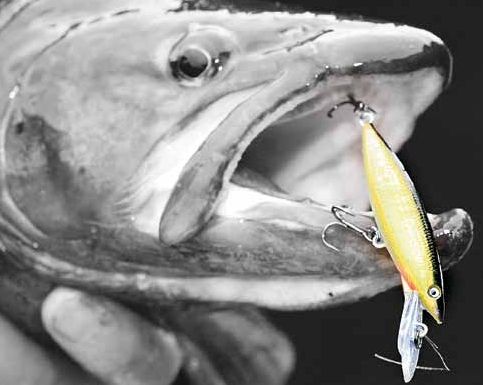
Presented from Issue 100
Considering the world class quality of our sea trout fishery, these fish are not sought after by enough anglers. Sea runners live in the salt water and run up our estuaries and rivers from the start of August to the middle of November. At this time of the year, they are here to eat the many species of fish that are either running up the rivers to spawn or are living in and around the estuary systems. Trout, both sea run and resident (Slob Trout) feed heavily on these small fish which darken in colouration as they move further into fresh water reaches.
The majority of these predatory fish are brown trout with rainbows making up a very small percentage of the catch. They can be found all around the state but it would be fair to say that the east coast is the least prolific of all the areas. They still run up such rivers as the Georges (and many others) but their numbers along with the quality of the fishing elsewhere make it difficult to recommend the area above the larger northern, southern and western rivers.
- Written by Stephen Smith - Rubicon Web and Technology Training
- Category: Saltwater and Estuary Fishing
- Hits: 14823
Read more: Sea runners - Early Season Excitement - Christopher Bassano
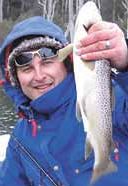 Presented from Issue 100
Presented from Issue 100
It’s been five years since I last did an article on Lake Echo so time for an update on my still favourite water. Each year I manage several trips which due to the distance from home are usually one or two night excursions. The spring months from September through till November still rate as the best times however the month of April in ideal conditions can be brilliant. By ideal conditions I mean rough as hell, in fact during April the rougher the better. Most Tassie autumns can be quite mild and some seasons I haven’t even gone as it was just too calm.
- Written by Stephen Smith - Rubicon Web and Technology Training
- Category: Lake Echo
- Hits: 6419
Presented from Issue 100
As the years progress and the fishing gods pull you further under their spell (and your partner allows you) somehow you seem to gather quite a collection of gear. Fly rods are no exception to this rule and I have even had to build an outside room so I am able to keep my collection away from certain eyes, if you know what I mean!. In recent years light line fishing has become more and more popular. With the number of people now going “Twigging” increasing, so to is the availability of the lighter line weight rods in varying lengths. Twigging is commonly referred to as fishing with 3 weight rods or lighter. You can now buy rods right down to a 000 line weight, and by the time you read this I will have one in the rod rack ( thanks Nick). Until that rod arrives at Essential Fly Fisher from the US the 3wt is as light as I own. Over the past few years I have become a lot more interested in the smaller stream fishing. There is just so many of these streams all around the state that are full of hungry fish it seems crazy not to fish them. As a result of this stream and river fishing I have built a small collection of 3wt rods.
- Written by Stephen Smith - Rubicon Web and Technology Training
- Category: Tackle, Boats and other Equipment
- Hits: 4789
Read more: A small love affair - Under the spell of 3 weights - Gavin Hicks
Presented from Issue 100
Most of us have learned the various basic fish cleaning techniques passed down over the years. I am always on the lookout for faster and better methods and have picked up a few that I will describe in detail in this article. Once you have practised them I,m sure you will use some of these new methods in preference to your old ways.
- Written by Stephen Smith - Rubicon Web and Technology Training
- Category: Cooking Fish
- Hits: 12455
Read more: Cleaning your catch - New techniques to try - Shane Flude
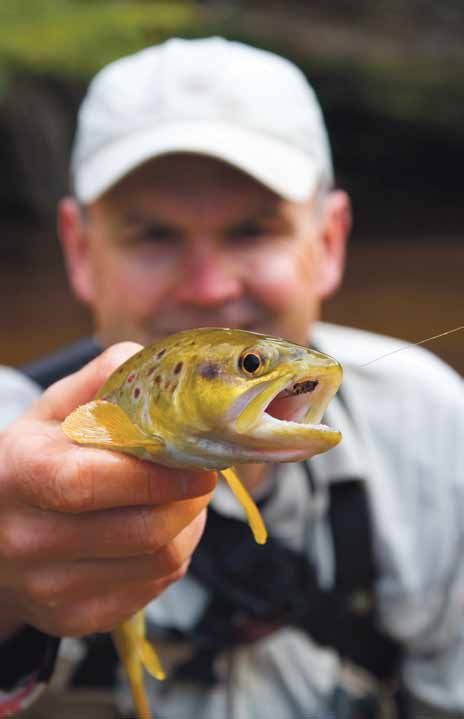 Presented from Issue 100
Presented from Issue 100
Having moved to the North East of Tasmania several years ago I set out to explore my local rivers and found them to be vastly different from the Mersey where I grew up. The rivers up this way tend to be much smaller, shallow sandy-bottomed streams. One of the first rivers I fished was a tributary of the George River, the Groom. It was early October and a nice sunny day as I headed north out of St Helens. As I went I stopped on each of the river bridges to have a look. I found the George River to be a little higher than what looked to be normal and discoloured so I continued on.
A few kilometres up the road I came to the Groom River and once again parked the car and had a look downriver from the bridge. This stream was also a little higher than normal but most sections flowed over a broad flat sandy bottom ranging between 30 and 50 cm deep. Much to my surprise looking downriver from the bridge I could quite clearly see five or six small fish feeding over the sand.
- Written by Stephen Smith - Rubicon Web and Technology Training
- Category: Esk and other Northern Rivers
- Hits: 8051
Read more: Sandy Secrets - Gems of the north east - Simon Hedditch
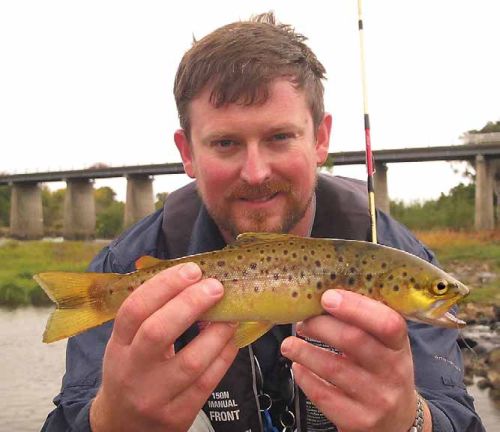 Presented from Issue 100
Presented from Issue 100
Have you ever driven over the South Esk River bridge at Perth? I am sure that most of us have. On every trip to Hobart, the idea of fishing this section of river has been in the back of my mind. As a child, I often fished the adjoining ‘Charles Berryman Picnic Reserve’ with my father. It was close to Launceston and had very good access to a small side-water that branched off the main river. Being European, we targeted species that would normally be considered as pests, such as redfin perch and tench. Sounds crazy I know, but prepared the correct way, tench were actually pretty good eating.
Most of the time we fished the old fashioned way, using worms suspended under a float. I also used small redfin-patterned Celtas on the odd occasion. The traditional red-coloured ones seemed to give the best results, with many trout caught on these metal spinners in the picnic reserve side-water. However, access to good fishing spots in the river itself was difficult, as the banks were overgrown with willows.
- Written by Stephen Smith - Rubicon Web and Technology Training
- Category: Kayak Fishing
- Hits: 7765
Read more: South Esk River Kayaking from Perth Bridge by Michal Rybka
Presented from Issue 100
How it was
Shore based angling
Over 20 years ago I was lucky enough to be taught to fish lakes like Arthurs by the great angler Shayne Murphy. One of the great lessons that I learnt from Murf was that in many cases you should simply use your boat to get to the best shore fishing locations quickly and efficiently. In those days we would pick the eyes out of the best locations then quickly move on to fresh and similar waters.
A few years later I started my guiding career and I bought a beautiful tri hull boat. For many years, just like Murf had taught me, I used this boat for transporting my clients to the best shore fishing locations for the weather and wind conditions. I well remember many times when my wading clients were ‘catching the clappers out of them’ as other anglers and guides drifted by flogging the water for little obvious results.
- Written by Stephen Smith - Rubicon Web and Technology Training
- Category: Trout Fishing
- Hits: 7705
Read more: Stop - Don’t Drift - You might even catch more by Peter Hayes
Presented from Issue 100
Weather - It’s the determining factor for most anglers in working out where to fish on a given day. “Too bright for here” ,”They won’t be tailing in this wind”, “It’s Easterly today so it’s going to be tough” these saying are all too familiar and they do have implications if we want success at catching a trout.
Picking the right weather can make or break an outing, a good decision can produce a red letter day while a bad decision can make chasing a trout hard work. So often I’ve spoken to visiting anglers who have struggled to catch fish without the all important local knowledge, they made decisions to visit waters which don’t fire in the wrong weather.
- Written by Stephen Smith - Rubicon Web and Technology Training
- Category: Meteorology and Weather
- Hits: 5342
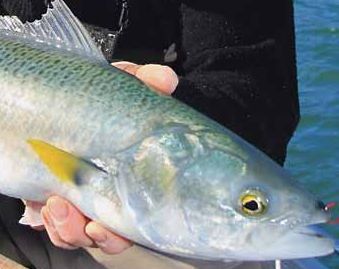 Presented from Issue 100
Presented from Issue 100
In Tasmania, larger Australian Salmon over two pounds are often called Black Back Salmon while the smaller models are known as Cocky Salmon. These fish are a valuable and much loved light tackle sports fish that are enjoyed by both land based and boating anglers all around Tasmania. They are a common catch in our estuaries, along our beaches and rocky headlands, and around the many small islands. They are a schooling fish that are constantly on the move along our coastlines, feeding predominantly on krill and small baitfish. They can be found in an estuary or along a particular part of the coast one week and then gone the next, as they move with the changing tides that influence the food they eat. Their presence rarely goes unnoticed when they turn up, as reports of anglers success quickly filters through the local angling community who gather in large numbers to make the most of these fantastic fish.
- Written by Stephen Smith - Rubicon Web and Technology Training
- Category: Australian Salmon
- Hits: 10530
Subcategories
Current TFBN
Click above for current issue content. The current issue of TFBN is extensive and topical. In Tackle Stores, Newsagents and by subscription.
Delivered to your door for $48 for 2 years (8 issues). To subscribe, send Mike $48 via www.paypal.com.au . (Basic instructions are here) The email is at Contact Us. Your address will be included from PayPal.
Or phone Mike with your c/c handy on 0418129949
Please ensure your details are correct, for Mike to organise delivery.
TFBN Newsletter Sign up Form
Why not submit an article ?
When you have finished for the day, why not have a brag about the ones that didn't get away! Send Mike an article on your fishing (Click here for contact details), and we'll get it published here. Have fun fishing - tasfish.com
Category Descriptions
Here is a list of all of the Article Categories. The number in Brackets, eg (13) is the number of articles. Click on Derwent River and all articles relating to the Derwent will be displayed in the central area.
Articles by Category
-
Rivers (3)
-
Saltwater and Estuary Fishing (149)
-
Kayak Fishing (34)
-
Lakes (1)
-
Great Lake (62)
-
Lake Leake (52)
-
Woods Lake (16)
-
Lake Augusta (11)
-
Huntsman Lake (13)
-
Lake Pedder and Gordon (10)
-
Lake Dulverton (5)
-
Lake Crescent (6)
-
Tooms Lake (10)
-
Lake Mackintosh (2)
-
Lake Barrington (5)
-
Little Lake (8)
-
Meadowbank Lake (5)
-
Lake King William (7)
-
Lake St Clair (2)
-
Western Lakes (12)
-
Arthurs Lake (35)
-
Lake Echo (7)
-
Four Springs (54)
-
Lake Sorell (7)
-
Lake Burbury (6)
-
Other Lakes (57)
-
Brushy Lagoon (18)
-
Little Pine Lagoon (5)
-
Penstock Lagoon (16)
-
Brumbys Creek (7)
-
-
Events (48)
-
Estuary Fishing (0)
-
Coastal Catches (46)
-
Super Trawler (46)
-
IFS, DPIPWE, MAST and Peak Bodies (435)
-
Commercial Interests (98)
-
Other (24)
-
TFBN Back Issues (8)
-
Fly Fishing (67)
-
Trout Fishing (252)
-
Meteorology and Weather (8)
-
Jan’s Flies (50)
-
Tuna Fishing and other Game Fishing (86)
-
Cooking Fish (19)
-
Fishing Information (1)
-
Fishing Books (8)
-
Videos (5)
-
Tackle, Boats and other Equipment (146)
-
World Fly Fishing Championship 2019 (2)
Popular Tags
windyty.com
Visit https://www.windyty.com/
Rubicon Web and Technology Training
Hello everyone, I thought it would be a good time to introduce myself.
My name is Stephen Smith and I have been managing the website tasfish.com since May 2009.
It has been an epic journey of learning and discovery and I am indebted to Mike Stevens for his help, support and patience.
I am developing a new venture Rubicon Web and Technology Training ( www.rwtt.com.au ). The focus is two part, to develop websites for individuals and small business and to train people to effectively use technology in their everyday lives.
Please contact me via www.rwtt.com.au/contact-me/ for further information - Stephen Smith.
From the Archives ... (last chance)
Sea runners - Early Season Excitement - Christopher Bassano
Presented from Issue 100
Considering the world class quality of our sea trout fishery, these fish are not sought after by enough anglers. Sea runners live in the salt water and run up our estuaries and rivers from the start of August to the middle of November. At this time of the year, they are here to eat the many species of fish that are either running up the rivers to spawn or are living in and around the estuary systems. Trout, both sea run and resident (Slob Trout) feed heavily on these small fish which darken in colouration as they move further into fresh water reaches.
The majority of these predatory fish are brown trout with rainbows making up a very small percentage of the catch. They can be found all around the state but it would be fair to say that the east coast is the least prolific of all the areas. They still run up such rivers as the Georges (and many others) but their numbers along with the quality of the fishing elsewhere make it difficult to recommend the area above the larger northern, southern and western rivers.
Read more ...
